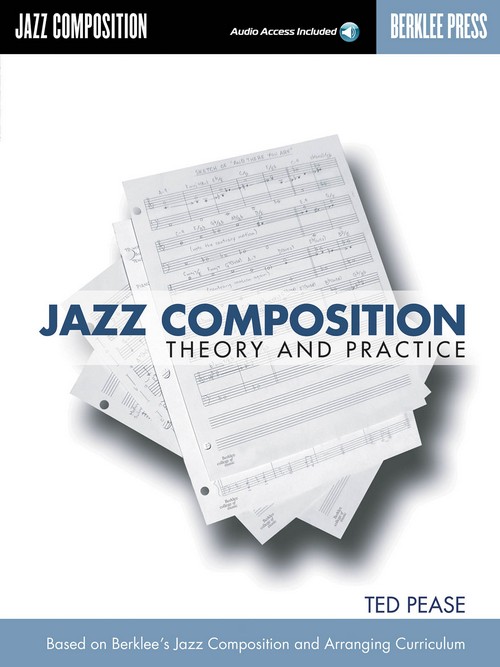
Jazz Composition: Theory And Practice
Pease, Ted
Berklee Press. 2004Ficha técnica
- EAN: 9780876390016
- ISBN: 978-0-87639-001-6
- Editorial: Berklee Press
- Fecha de edición: 2004
- Encuadernación: Rústica
- Dimensiones: 23x31
- Idioma: Inglés
- Nº páginas: 238
Bajo pedido
Sin stock. Si se pide hoy, se estima recibir en la librería el 02/05/24¡GASTOS DE ENVÍO GRATIS!
PVP. 63,30€
Añadir a la Lista de deseos
Based upon the Berklee Jazz Composition and Arranging Curriculum, this fully comprehensive guide covers all aspects of writing effective and inventive Jazz compositions.
A culmination of Profesor Ted Pease's twenty-five years of eaching jazz Composition at Berklee College of Music.
When you think of great jazz composers, who comes to mind? Perhaps Duke Ellington, Dizzy Gillespie, Thelonious Monk, Charles Mingos, Gil Evans, Thad Jorres, or Bob Brookmeyer. This book is about what they (and many others) do, and how they do it so well.
Jazz composition has evolved finto a disciplined art that often evidences great emotional depth and breadth of sophistication. In Jazz Composition: Theory and Practice, Berklee College of Music Profesor Ted Pease demystifies the proceses involved in eomposing tones as well as episodic and extended jazz works.
Jazz Composition: Theory and Practice will help you to:
- Improve your writing in all jazz styles-from blues to fusion-with effective approaches to melody-writing, such as repetition, sequence, motivic transformation, and embellishment
- Create great melodies built on intervallic patterns, guide tonelines, compound unes, antecedent/consequent phrasing, and melodic tension
- Learn to think creatively when working with tonal and modal harmony, covering such harmonic techniques as inversions, pedal point, constant structures, and reharmon i zation
- Arrange and format all parts of song form, including intros, interludes and endings, and backgrounds
- Apply what you have learned to writing for jazz ensembles of any size from solo piano to quartet or quintet, and from saxophone section to big band
Numerous writing exercises are included to help improve the melodic, harmonic, and rhythmic effectiveness of your jazz compositions. Additionally, al] compositional elements are reinforced with listening examples on the included audio, where, among other things, you will benefit from a guided listening tour of an estire extended jazz work, with detailed annotation by the composer/author.
Audio Access Included in www.halleonard.com/mylibrary
CONTENIDO:
Recorded Examples
Preface
Introduction
What is Jazz?
What is Jazz Composition?
Prerequisites: What Do 1 Need to Know?
Acknowledgments and Thanks
About the Author
How to Use this Book and Audio
Review
Scales
Modes
Tensions
Approach Notes and Other Embellishments Anticipation and Delayed Attack Guide Tones
Chapter 1. Melodic Considerations
Definitions
Exercise
Melodic Rhythm
Melodic Rhythm
Density as a Function of Style
Exercise
Scale Resources
Interval Patterns
Exercise
Melodic Variation via Modal Interchange
Exercise
Motivic Devices and the Rudiments of Form
Repetition
Sequence
Motivic Transformation
Motivic Embellishment
Exercise
Motifs Based on Intervallic Patterns
xercise
Melodies Based on Guide Tones
Exercise
Embellishing a Guide Tone Line
Exercise
Melodies Based on Compound Lines
Exercises
Antecedent and Consequent Phrases
Exercises
Pitch Contour and Range
Apex (Clímax)
Exercise
Melodic Tension as a Function of Style
Exercises
Source Material-Melodic
Considerations
Chapter 2. Harmonic Considerations
Tonal Harmony (Major Key Orientation)
Exercises
Tonal Harmony (Minor Key Orientation)
Exercises
Modal Harmony
Inverted Voicings in Fourths
Modal Approach Chords
Modal Melodies
Exercises
Harmonic Variation via Modal Interchange
Exercise
Chromatic Harmony
Harmonic Rhythm (and Density)
Modulations
Exercises
Ostinato
Exercise
Inversions and Other Slash Chords
Pedal Point and Constant Structures
Exercise
Pedal Point and Pandiatonicism
Exercises Harmonization
Exercises
Reharmonization
Exercise
Source Material
Harmonic Considerations
Chapter 3. Blues and Song Form
Form
The Blues
Blues: Harmonic Form
Blues: Melodic Form
Exercises
Source Material-Blues Rhythm Changes
Exercise
Source Material Rhythm Changes aaba Song Form
Warm-Up Exercise Source Material-aaba form abac Song Form
Exercises
Source Material-abac form
Ostinatos (Revisited) Exercises
Source Material-Ostinatos abca Song Form
Exercise
Through-Composed Tunes Exercise
Exercises
Source Material Through-Composed Tunes
Chapter 4. Arranging and Formatting Considerations
Getting Your Music Played
Two-Part Soli Writing
Exercises
Background Writing/ Deriving Counterpoint from Guide Tones
Exercises
Intros, Interludes, and Endings
The Arranger's Chorus "Group Effort"
Exercises
Source Material
Chapter 5. Metric Considerations
Metric Modulation
Exercises
Source Material
Chapter 6. Fusion
Fusion Melody
Fusion Harmony
Fusion Rhythm
Fusion Instrumentation
Chapter 7. Episodic Form
"In Celebration of Saxophones"
Exercises
Source Material-Episodic Compositions
Chapter 8. Motivic Composition
Exercises
Internal Form for Motivic Composition
"Dynamic Duo" Internal Form
Exercise
Source Material-Motivic Compositions
Chapter 9. Extended Works
Motivic Continuity in Extended Works
External Form for Extended Works
Internal Forms for Extended Works
Internal Form for "Initiations"
Internal Form for "Reflections"
Internal Form for "This Is What We Do"
Exercise
Bibliography




